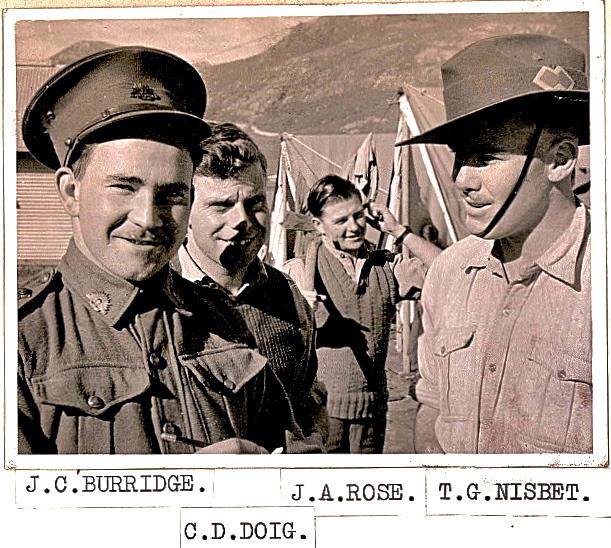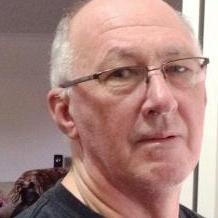-
The story of the 2/2 begins in early 1941 when about 270 officers and men were trained at a secret army base at Wilsons Promontory, Victoria, to be sent on secret missions into enemy-occupied territory in Europe. Japan’s entry into the war changed their destination.
 The men of this unit were specially chosen for their mental and physical toughness, and for their knowledge of the bush. Many were drawn from the wheat belt of Western Australia and beyond, and were at home in the bush and knew instinctively how to live off the land. More than half the men in the company’s three original platoons came from WA, while the officers and signallers were drawn mainly from the eastern states. The recruits included the likes of Merv Wheatley, a horse breaker, shearer and kangaroo shooter, as well as top footballers like Joe Poynton and Kevin Curran, who played first grade for Hawthorn. They were trained in April-May 1941 by a special mission of British officers who came from the newly formed Special Operations Executive (SOE). The mission included the legendary adventurer and mountaineer, Freddie Spencer Chapman. When they marched out of “The Prom” in May 1941, wearing their distinctive double-red diamond patch, they were known as the 2nd Independent Company. Later in the war they became the 2/2 Commando Squadron, but they were more often known as “the second-second”.
The men of this unit were specially chosen for their mental and physical toughness, and for their knowledge of the bush. Many were drawn from the wheat belt of Western Australia and beyond, and were at home in the bush and knew instinctively how to live off the land. More than half the men in the company’s three original platoons came from WA, while the officers and signallers were drawn mainly from the eastern states. The recruits included the likes of Merv Wheatley, a horse breaker, shearer and kangaroo shooter, as well as top footballers like Joe Poynton and Kevin Curran, who played first grade for Hawthorn. They were trained in April-May 1941 by a special mission of British officers who came from the newly formed Special Operations Executive (SOE). The mission included the legendary adventurer and mountaineer, Freddie Spencer Chapman. When they marched out of “The Prom” in May 1941, wearing their distinctive double-red diamond patch, they were known as the 2nd Independent Company. Later in the war they became the 2/2 Commando Squadron, but they were more often known as “the second-second”.
The Timor Campaign
The 2/2 men sailed from Darwin on 8 December 1941 bound for the island of Timor. They left Darwin just hours after they learned of the bombing of Pearl Harbor. The company was to form part of Sparrow Force, a 1,400-man unit that was one of several deployed to islands north of Australia as part of what proved to be a disastrous deployment by the Australian army. Sparrow Force first landed at Kupang, capital of the Dutch Territory of West Timor, before then being deployed to Dili, capital of the neutral territory of Portuguese Timor on 17 December 1941.
 The deployment to Timor caused an international furore because the Portuguese government in Lisbon protested. The UK government agreed and it persuaded Australia and the Dutch to withdraw their forces. Before they could withdraw, the Japanese put in place an invasion plan that began with the bombing of Darwin on the morning of 19 February 1942. The bombing was specifically designed to knock out Allied air and naval power based in and around Darwin so that these forces could not be used to counter attack – a fact not recorded in most histories of these events. That same evening, the Japanese landed about 6,000 troops on east and west Timor.
The deployment to Timor caused an international furore because the Portuguese government in Lisbon protested. The UK government agreed and it persuaded Australia and the Dutch to withdraw their forces. Before they could withdraw, the Japanese put in place an invasion plan that began with the bombing of Darwin on the morning of 19 February 1942. The bombing was specifically designed to knock out Allied air and naval power based in and around Darwin so that these forces could not be used to counter attack – a fact not recorded in most histories of these events. That same evening, the Japanese landed about 6,000 troops on east and west Timor.
Unlike most of Australia’s forces that were captured by the Japanese, the 2/2 men were lucky to escape the initial invasion because they were not following their orders to the letter. Instead of being based at the airfield in Dili, all but 20 men had been moved into the mountains so that they could recover from, or avoid, malaria. The men had been so badly equipped that, after a short time in Dili, nine out of 10 came down with malaria. Of the 20 men left to guard the airfield, 17 escaped the Japanese clutches, largely due to the skill and bravery of Private Joe Poynton, who was later awarded a DCM.
During their two months on Timor, the 2/2 men had established very good relations with the local villagers, largely because they treated them with respect. These relations proved decisive when they came to rely on the villagers to protect them from the Japanese and allow them to take offensive action.
The Japanese demanded that the 2/2 Company’s commanders surrender, telling them that as their main force had surrendered, they should too. When the men answered this demand with numerous deadly ambushes, the Japanese declared them “outlaws” and warned that, if they did not surrender, they “would not be given POW privileges and, if captured, would be executed”. As the 2/2 men hit the Japanese with relentless raids, they appeared and operated like bushrangers of Australia’s wild colonial past. Many of the men grew long beards – razors were unobtainable – and resembled the members of the Kelly Gang.
 To survive and fight a campaign of David and Goliath proportions required ingenuity, imagination, and mateship on a mammoth scale. Ingenuity, like rebuilding a radio from spare parts so that the force could contact Australia and tell the army chiefs they were indeed still fighting.
To survive and fight a campaign of David and Goliath proportions required ingenuity, imagination, and mateship on a mammoth scale. Ingenuity, like rebuilding a radio from spare parts so that the force could contact Australia and tell the army chiefs they were indeed still fighting.
Imagination, like mobilising hundreds of people to move supplies out of the enemy’s reach without having the means to communicate with or compensate the willing workers.
It demanded mateship, not just among the Australians, but with the local population. The skill and fitness of the 2/2 Company men would have counted for nothing had they not won the hearts of the hardy mountain people of Portuguese Timor. After entering the neutral territory uninvited, and then drawing the Japanese there, the Australians pulled off a remarkable feat in bush diplomacy and mass mobilisation, despite having little fore-knowledge of the local people and their language.
Many young Timorese and Portuguese volunteered to serve alongside the Australians. They became the eyes and ears of the soldiers, and by hauling supplies and equipment as well they made the 2/2 Company a vastly more mobile and effective guerrilla force. Some actually carried arms and took part in engagements with the enemy. Many, many more Timorese villagers gave the Australians food and shelter and whatever else they needed, and they refused to inform on them. The result was a rag-tag army of professionals and volunteers that is unrivalled in Australian military history.
 The running of a guerrilla operation involving several hundred soldiers was a significant feat for a conventional army. The Australians did not look anything like the people around them; they were unable to follow Mao Zedong’s rule that “a guerrilla must move among the people as a fish swims in the sea”.
The running of a guerrilla operation involving several hundred soldiers was a significant feat for a conventional army. The Australians did not look anything like the people around them; they were unable to follow Mao Zedong’s rule that “a guerrilla must move among the people as a fish swims in the sea”.
While not being invisible like conventional guerrilla fighters, the Australians gained an invisible shield by virtue of popular support. This enabled them to man observation posts within 2km of the capital, Dili, making the Timor operation part of the “coast-watchers” network. The information from these posts informed scores of accurate air strikes dispatched from Darwin on enemy shipping and facilities.
The skill and calibre of the individuals in the 2/2 Company and the support of the Timorese explain how this small force was able to kill hundreds of enemy soldiers in dozens of close-quarters actions over a period of 10 months, and suffer an incredibly small number of casualties – just ten men in combat. Overwhelmingly, the support of the Timorese population who protected this force contributed to this extraordinary outcome.
Timor was by no means the main game when it came to turning back the Japanese tide in New Guinea and the Pacific, but it was no mere sideshow either. The 400 Australians in Portuguese Timor – later augmented to about 700 with reinforcements from the 2/4 Company – succeeded in tying up several thousand enemy troops in mid-1942 at a time when the Japanese army was fighting its way down the Kokoda Track and came within striking distance of Australia. The Japanese troops in Timor, which rose to nine battalions or more than 9,000 men by the end of 1942, could have made a real difference had they been deployed in the Kokoda campaign or elsewhere.
Prime Minister John Curtin highlighted the importance of this small redoubt when he looked back at the long year that was 1942.
QuoteOur guerrilla forces in Timor have been doing bold and courageous work. Though the spotlight has been more on New Guinea because of the larger forces engaged, the people of Australia should not overlook the importance of Timor as a base for operations against the north-west of Australia.
 An important perspective on the 2/2’s guerrilla campaign, and how it compared to New Guinea, was provided by David Dexter, a platoon commander with the 2/2 Company who went on to lead offensive actions to recapture New Guinea in the latter years of the war. After the war Dexter wrote Volume VI of the official history of the Second World War, The New Guinea Offensives. For this senior army officer, diplomat, war historian and son of a Boer war and Gallipoli veteran, the Timor campaign could not to compared to anything else he had seen or heard of in Australian military history. “They were a remarkable unit,” he said of the 2/2″ Company, “like no other in Australian military history.” The 2/2’s year-long campaign was fought by a “tattered cavalry of Australians and Timorese” in the “real wild hills” of the colony.
An important perspective on the 2/2’s guerrilla campaign, and how it compared to New Guinea, was provided by David Dexter, a platoon commander with the 2/2 Company who went on to lead offensive actions to recapture New Guinea in the latter years of the war. After the war Dexter wrote Volume VI of the official history of the Second World War, The New Guinea Offensives. For this senior army officer, diplomat, war historian and son of a Boer war and Gallipoli veteran, the Timor campaign could not to compared to anything else he had seen or heard of in Australian military history. “They were a remarkable unit,” he said of the 2/2″ Company, “like no other in Australian military history.” The 2/2’s year-long campaign was fought by a “tattered cavalry of Australians and Timorese” in the “real wild hills” of the colony.
Despite the many extraordinary facets to this epic in guerrilla warfare it appears as a minor footnote in most histories of the Second World War, overshadowed by the New Guinea and Pacific campaigns. Indeed, Australia’s official history of the Second World War includes most of the Timor campaign as an appendix. Few people today are even aware that Australian forces fought in Portuguese Timor, and that as many as 40,000 – 60,000 Timorese died as a result of this conflict, far exceeding the losses of any other nation that supported Australians in war.
With thanks to Paul Cleary.
-
Books
Ayris, C, All the Bull’s men : no. 2 Australian Independent Company (2/2nd Commando Squardon)
Click here to purchase a digital copy of All The Bull's Men.Campbell, A, The double reds of Timor JBMA, Swanbourne. [1995]
Collins, P, Strike Swiftly – The Australian Commando Story, Watermark Press, Sydney [2005]
Doig, C, A history of the 2nd Independent Company and 2/2 Commando Squadron, Self-published. [1986]
White, K, Criado : a story of East Timor, Indra Publishing, Briar Hill, Vic. [2002]
-
 Journalist and author Paul Cleary has written a highly acclaimed history of the 2/2’s Timor campaign titled: 'The Men Who Came out of the Ground'.
Journalist and author Paul Cleary has written a highly acclaimed history of the 2/2’s Timor campaign titled: 'The Men Who Came out of the Ground'.
Helen Crompton wrote in The West Australian: “If all history books were written like this, kids might actually ask for their homework. Cleary writes a raw, even-handed account. His research is deep and wide and it is this scope that makes the narrative so visual. Cleary has done a remarkable job setting the record straight – and adding significantly to the record.”
The Sydney Morning Herald described it as “Breathtaking in its scope, riveting in its research…intensely readable history”.
Purchase an ebook version of the book via Amazon using this link: https://www.amazon.com.au/Men-Who-Came-Out-Ground/dp/0733636608
-
DVDs
-
Other Resources
http://www.awm.gov.au/atwar/timor.asp
http://www.awm.gov.au/atwar/timor_photo.asp
http://www.awm.gov.au/atwar/remembering1942/timor/transcript.asp
http://www.awm.gov.au/units/unit_13313second_world_war.asp
http://www.awm.gov.au/atwar/remembering1942/timor/
http://www.eurekastreet.com.au/article.aspx?aeid=22909
http://www.eurekastreet.com.au/article.aspx?aeid=22910
http://www.eurekastreet.com.au/article.aspx?aeid=12197
http://www.legacy.com.au/
http://www.toyotafound.or.jp/english/00topics/topics02/2008-0808.html
A Forgotten Hero of World War II
WA Museum - Debt of Honour
AWM52 25/3/2 - 2/2 Independent Company
Tales of the Second Second – Copyright Jenny Beahan (Aitken)








